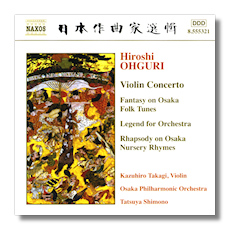
The Internet's Premier Classical Music Source
Related Links
- Latest Reviews
- More Reviews
-
By Composer
-
Collections
DVD & Blu-ray
Books
Concert Reviews
Articles/Interviews
Software
Audio
Search Amazon
Recommended Links
Site News
 CD Review
CD Review
Hiroshi Ohguri

- Violin Concerto
- Fantasy on Osaka Folk Tunes
- Legend for Orchestra
- Rhapsody on Osaka Nursery Rhymes
Kazuhiro Takagi, violin
Osaka Philharmonic Orchestra/Tatsuya Shimono
Naxos 8.555321 DDD 67:42
If you want to tease your friends, play Hiroshi Ohguri's Violin Concerto for them and challenge them to identify the composer, or even the composer's nationality. It's a difficult task. When he wasn't intentionally quoting Japanese melodies, his style of composition was cosmopolitan. In the Violin Concerto, composed in 1963, I hear hints of Khachaturian and Bartók (at his most outgoing), and even a pinch and a dash of Samuel Barber. These influences are not surprising, because Ohguri (1918-1982) spent about twenty-five years playing the French horn in Japan's most prominent symphony orchestras. When someone spends so much time playing other composers' music, it's inevitable that he will start to bring his work "home" with him. He appears not to have spent time studying in Europe, although European influences came to him in his native Japan, and he was a close friend of conductor Takashi Asahina, who eventually became something of a cult figure in the West before his death in 2001.
Ohguri was born in the city of Osaka, and that is where he spent most of his professional career, first primarily as a hornist, and then as a composer. Morihide Katayama takes pains in the excellent booklet notes to contrast residents of Osaka with residents of Tokyo. They speak different dialects, and the people of Osaka are reputed to be more informal, friendly, and garrulous than their cousins in Tokyo. To some extent, these characteristics are said to be reflected in Ohguri's music. I'd definitely use those words to describe the candid, kinetic Violin Concerto which buries Japanese influences (everything from a suggestion of Shinto festival music to variations on a Japanese nursery rhyme) in a bustling, overstuffed framework. The soloist is kept busy, but he isn't given the opportunity to show off at center stage as one expects in a traditional violin concerto. All in all, it's an attractive work, but something of a puzzle.
The three shorter works are for orchestra alone. Again, they are densely composed but not difficult to enjoy. One could argue that the Fantasy on Osaka Folk Tunes and the Rhapsody on Osaka Nursery Rhymes (its whirling conclusion in particular) are eastern cousins to Kodály's Dances of Galánta. The Legend for Orchestra, originally written for symphonic band, is based on the story of Amaterasu, the sun god, who is tricked into coming out of hiding by a kind of mass celestial belly dance. The story clearly feeds Ohguri's maximalist tendencies!
Fittingly, the performances are by the Osaka Philharmonic – a fine orchestra, but perhaps a little taxed by the composer's restless pen. Takagi makes a positive impression in the Concerto, but, as indicated, it is not an entirely gratifying vehicle for the soloist. The engineering splendidly captures the sound of the musicians in Osaka Philharmonic Hall.
This is a curiosity, then, but worth exploring, if you're inquisitive.
Copyright © 2003, Raymond Tuttle


















